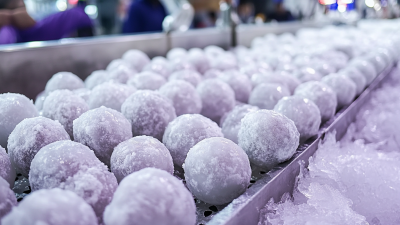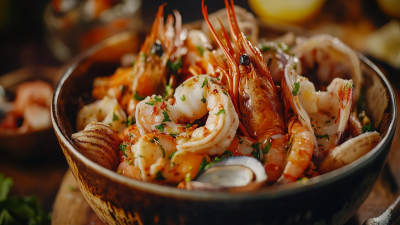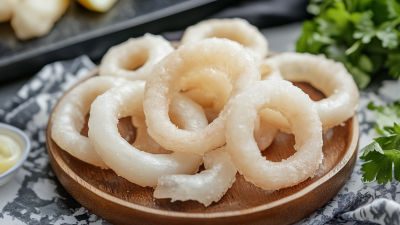Frozen fishballs have rapidly gained popularity in the global frozen food market, with industry reports predicting a compound annual growth rate (CAGR) of 4.5% from 2021 to 2026. This surge can be attributed to several factors including the rising demand for convenient meal options, the growing trend of home cooking, and the increasing popularity of Asian cuisines among consumers worldwide. According to a survey by the Food Research Institute, approximately 60% of households have incorporated frozen seafood products into their diets, highlighting the shifting preferences towards quick and nutritious cooking solutions. As frozen fishballs emerge as a staple ingredient in various dishes, understanding the factors driving their popularity will provide invaluable insights for both consumers looking to elevate their culinary experiences and businesses striving to meet market demands.

The frozen fishball industry has been experiencing remarkable growth in recent years, driven by increasing consumer demand for convenient and healthy food options. According to a recent report from Allied Market Research, the global frozen fishball market was valued at approximately $1.5 billion in 2020 and is projected to reach nearly $2.7 billion by 2027, growing at a CAGR of 8.3%. This surge can be attributed to the rising popularity of Asian cuisine and the expanding presence of frozen seafood products in supermarkets and online grocery platforms.
Consumer preferences are shifting towards quick-preparation meals that do not compromise on nutrition. Frozen fishballs, which are rich in protein and omega-3 fatty acids, are becoming a favored choice among health-conscious individuals and busy families. The same industry report highlights that North America and the Asia Pacific regions are at the forefront of this trend, with e-commerce sales of frozen food experiencing a significant boost during the COVID-19 pandemic. As a result, businesses are increasingly investing in innovative packaging and flavor variations to cater to diverse tastes, enhancing the appeal of frozen fishballs across various markets.
This bar chart illustrates the market size of frozen fishballs across different regions in 2023. The data reflects the popularity and growing demand for frozen fishballs globally, highlighting Asia as the largest market.
The rising popularity of frozen fishballs across the globe can be attributed to several key factors, underlining their appeal in both retail and culinary arenas. First and foremost, convenience plays a pivotal role in this trend. Consumers are increasingly seeking quick and easy meal solutions, and frozen fishballs provide a versatile option that can be prepared in minutes. According to a recent report by Statista, the frozen food market is projected to witness a compound annual growth rate (CAGR) of 4.5% from 2021 to 2025, indicating a robust demand for convenient food options like fishballs.
Another driving force is the growing health consciousness among consumers. Frozen fishballs are often made from healthier fish species, providing a lean source of protein. A study by the Global Frozen Fish Market revealed that 62% of respondents preferred frozen seafood options due to perceived health benefits. Additionally, fishballs can fit into various diets, appealing to a broader audience.
Tips: When selecting frozen fishballs, look for products with high fish content for better quality. Also, explore different cooking methods; steaming or air-frying can enhance both flavor and nutritional value. As international cuisines continue to blend, fishballs can serve as a canvas for innovative recipes that cater to diverse palates.

Frozen fishballs have gained immense popularity among consumers, not just for their delightful taste but also for their nutritional benefits. Packed with protein and essential nutrients, they serve as a quick and convenient source of sustenance for busy individuals seeking healthy meal options. The appeal of frozen fishballs lies in their ability to maintain nutritional value while offering a versatile base for a variety of dishes, from soups to stir-fries. This adaptability ensures that they can easily fit into many diets, promoting balanced meals.
However, consumer perceptions of frozen foods can be complex. A recent study highlighted that many individuals harbor skepticism about the nutritional quality of frozen products, often influenced by concerns over freshness and health. These fears can lead to resistance against purchasing frozen meals, even when options like frozen fishballs offer significant health benefits. With the recent changes in food packaging regulations aiming to better inform consumers, it is crucial for brands to transparently communicate the nutritional advantages of frozen foods to combat misconceptions and enhance consumer confidence.
With the rise of culinary trends, the popularity of frozen fishballs has surged, driven by innovative flavor profiles that appeal to a diverse range of consumers. According to market research from Statista, the frozen seafood market is projected to grow at a CAGR of 4.5% over the next five years, highlighting the increasing demand for quick and convenient meal options. Consumers are not just looking for traditional seafood flavors; they crave unique twists such as spicy sriracha, sweet teriyaki, and even fusion options like curry-infused fishballs. This shift towards bold flavors is reshaping the landscape of frozen fishball sales, making them a versatile ingredient in various cuisines.

If you're looking to elevate your dish, try incorporating fishballs into different culinary applications. For example, consider adding them to stir-fries or soups where they can soak up the surrounding flavors. Another tip is to pair them with dipping sauces that complement their unique tastes; a zesty lime-cilantro sauce can enhance spicy varieties while a creamy garlic dip may appeal to those who prefer milder flavors. By staying attuned to culinary trends and experimenting with diverse flavor combinations, retailers can capture consumer interest and drive frozen fishball sales.
The rising popularity of frozen fishballs can be attributed significantly to their eco-friendly production practices. In recent years, consumers have become increasingly aware of the environmental impacts of their food choices. The global frozen fish market is projected to reach $82 billion by 2027, with sustainability as a key driver for growth, as highlighted by a recent report from Allied Market Research. Sustainable sourcing and responsible fishing methods have transformed fishballs into a preferred choice for environmentally conscious consumers, making them a staple in many households.
A notable trend is the shift towards aquaculture, which reduces overfishing and promotes biodiversity. Research indicates that sustainably farmed fish can yield up to 10 times more protein per acre compared to traditional livestock, emphasizing the efficiency of this practice. As companies adopt eco-friendly methods, such as using recyclable packaging and reducing carbon footprints, the appeal of fishballs continues to grow among consumers looking for guilt-free options.
**Tip:** When selecting fishballs, look for certifications such as MSC (Marine Stewardship Council) or ASC (Aquaculture Stewardship Council) to ensure that your purchase supports sustainable practices.
**Tip:** Always check the ingredients list for transparency; choosing fishballs made with natural ingredients not only benefits your health but also reinforces support for sustainable food systems.






